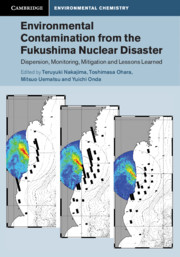 Environmental Contamination from the Fukushima Nuclear Disaster
Environmental Contamination from the Fukushima Nuclear Disaster Book contents
- Environmental Contamination from the Fukushima Nuclear Disaster
- Cambridge Environmental Chemistry Series
- Environmental Contamination from the Fukushima Nuclear Disaster
- Copyright page
- Contents
- Contributors
- Preface
- Acknowledgements
- Part I Transport of Radioactive Materials in the Environment
- 1 Introduction
- 2 Estimation of Environmental Releases of Radioactive Materials
- 3 Diffusion in the Atmosphere
- 4 Global Transport of Radioactive Materials
- 5 Ocean Transport of Radioactive Materials
- 6 Diffusion and Deposition of Radioactive Materials in the Terrestrial Environment
- Part II Development and Future Issues for the Infrastructure of Disaster Prevention
- Part III Lessons and Future Issues from the Fukushima Accident
- Glossary
- Names of Locations
- Index
- References
4 - Global Transport of Radioactive Materials
from Part I - Transport of Radioactive Materials in the Environment
Published online by Cambridge University Press: 16 August 2019
- Environmental Contamination from the Fukushima Nuclear Disaster
- Cambridge Environmental Chemistry Series
- Environmental Contamination from the Fukushima Nuclear Disaster
- Copyright page
- Contents
- Contributors
- Preface
- Acknowledgements
- Part I Transport of Radioactive Materials in the Environment
- 1 Introduction
- 2 Estimation of Environmental Releases of Radioactive Materials
- 3 Diffusion in the Atmosphere
- 4 Global Transport of Radioactive Materials
- 5 Ocean Transport of Radioactive Materials
- 6 Diffusion and Deposition of Radioactive Materials in the Terrestrial Environment
- Part II Development and Future Issues for the Infrastructure of Disaster Prevention
- Part III Lessons and Future Issues from the Fukushima Accident
- Glossary
- Names of Locations
- Index
- References
Summary
The radioactive materials that were released into the atmosphere due to the Fukushima Daiichi Nuclear Power Station (FDNPS) accident not only spread within Japan but also dispersed over the entire globe through atmospheric flows. As described in Chapter 3, there were strong westerlies and a low pressure that passed over the Tohoku region when the accident occurred, which transported most of the released radioactive materials towards the east in the form of gas and/or aerosol particles. Previous studies on atmospheric trace materials (e.g. Okada et al., 1992; Husar et al., 2001; Uno et al., 2009) have shown that aerosol particles can be transported over long distances. A good example is the air pollution originating over East Asia, such as the Asian dust that arises from the dry land of China and Mongolia, which has been identified in the USA as well as over the Pacific Ocean. Therefore, to understand the entire picture of the radioactive pollution caused by the accident, it is necessary to clarify how the radioactive materials were transported, as well as deposited, over Japan and around the world. The radioactive materials that were produced by the FDNPS accident have been detected throughout the world. To date, numerical simulations of the transport of radioactive materials over large areas have been carried out by various organisations. In this chapter, we will discuss the global transport of the radioactive materials caused by the accident by examining their detection around the world, the characteristics of the atmospheric transport of radioactive materials using global numerical simulations, and estimations of the release of the radioactive materials using observations and numerical simulations.
- Type
- Chapter
- Information
- Environmental Contamination from the Fukushima Nuclear DisasterDispersion, Monitoring, Mitigation and Lessons Learned, pp. 112 - 127Publisher: Cambridge University PressPrint publication year: 2019


